|
|
|
| My Favourite Planet > English > Middle East > Turkey > Ephesus > photo gallery |
| Ephesus, Turkey |
Ephesus photo gallery 1 |
 |
 |
33 of 62 |
 |
 |
|
| |
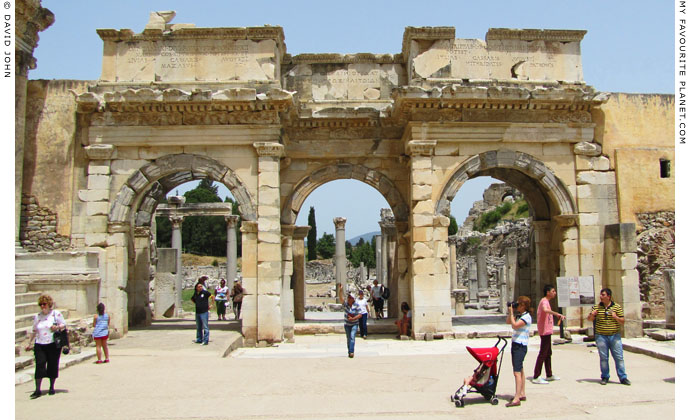
The Gate of Mazeus and Mithridates to the Lower (Commercial) Agora. |
| |
The Gate of Mazeus and Mithridates
The monumental triple-arched gateway (also known as the Gate of Augustus, or the South Gate) stands to the southeast corner of the Lower (Commercial) Agora (also known as the Tetragonos Agora), on the north side of the square of the Library of Celsus. It was built around 4-3 BC and dedicated by two former slaves, Mazeus and Mithridates, who had been freed by Emperor Augustus (reigned 27 BC-14 AD) and apparently become very prosperous in Ephesus. See photos below of the inscriptions dedicated by Mazeus and Mithridates to Augustus and members of his family [1]: his third wife Livia Drusilla, his daughter Julia (Julia the Elder, by his second wife Scribonia) and her husband Marcus Vipsanius Agrippa.
It was designed in the form of a triumphal arch, and richly decorated at the front and within each of the three arched passages, which are connected to each other by doorways with skylights (see next page). See a photo of a relief of Aphrodite on the central arch of the gate on the next page. The back of the gate is quite plain (see photo below).
During the reigns of Emperors Claudius (41-54 AD) and Nero (54-68 AD) alterations were made to the gate, an extension was built on the north side, and it was intergrated into the newly redesigned agora, the ground level of which was raised 2-3 metres. Over the centuries various inscriptions with market regulations and other official announcements were added. The building collapsed during an earthquake in the 13th century.
The Gate was first excavated in 1903 and restored 1980-1989 (see below), using original parts discovered during the 1903 excavation.
A marble slab with an inscription mentioning Mithridates Agrippa can be seen on the ground, on the other side of the square on which the gate and Library of Celsus stand. The inscription is thought to be from the grave of the Mithridates who had the gate built. |
|
| |
| |
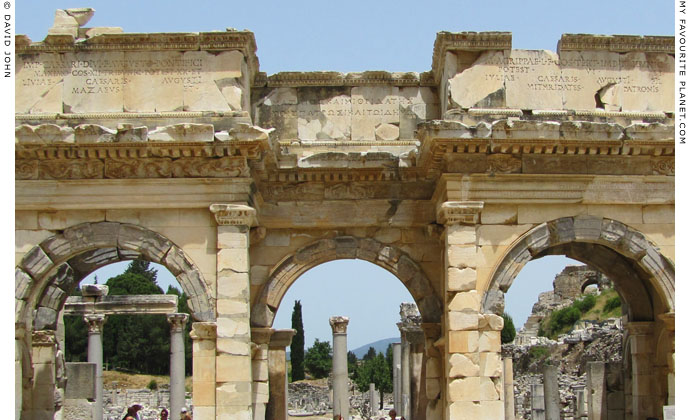
The dedicatory inscription of Mazeus and Mithridates in three parts above the gateway.
The inscriptions on the left and right are in Latin, with dedications to Emperor Augustus,
his wife Livia Drusilla, his son-in-law and closest ally Marcus Vipsanius Agrippa, and his
daughter Julia (Julia the Elder). The first is signed by Mazeus, the second by Mithridates.
The central inscription is in Greek. The letters were originally inlaid with bronze.
The dedication is heavily abbreviated, but has been translated:
"For Emperor Caesar Augustus, the son of the god, Pontifex Maximus,
who was consul twelve and tribune twenty times; and Livia (wife of) Caesar Augustus;
Marc Agrippa, the son of Lucius, who was consul three times and tribune six times;
and Julia, daughter of Caesar Augustus.
Mazeus and Mythridates to their master and the people."
The photos below show details of the inscriptions, all to approximately the same scale. |
| |
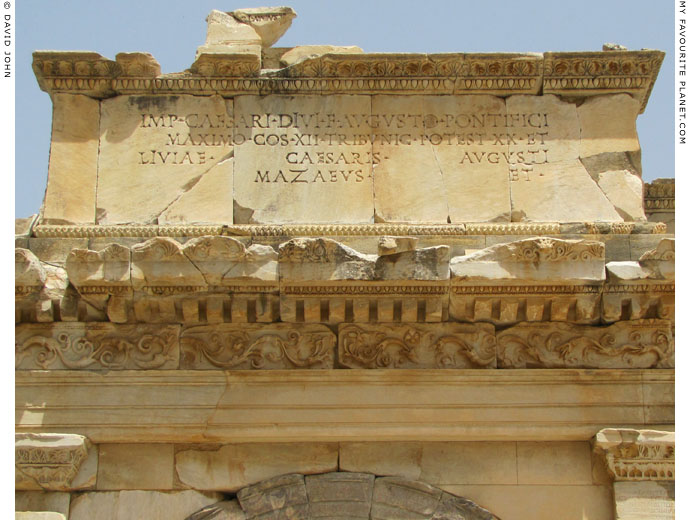
The western inscription, over the western arch (on the left) of the gate, signed "Mazeus et".
The signature of Mithridates is over the eastern arch (on the right, see below).
The inscription in Latin mentions Augustus and his wife Livia Caesar Augusus (Livia Drusilla).
IMP • CAESARI • DIVI • F • AVGVSTO • PONTIFICI
MAXIMO • COS • XII • TRIBVNIC • POTEST • XX • ET
LIVIAE • CAESARIS • AVGVSTI
MAZAEVS • ET • |
| |
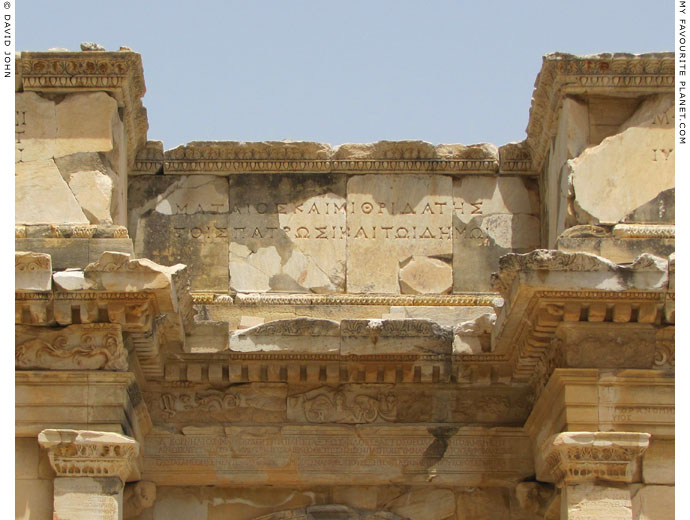
The inscription over the central arch of the gate, with the dedication,
in Greek, by Mazeus and Mithridates to their patron and the demos (city).
ΜΑΞΑΙΟΣ ΚΑΙ ΜΙΘΡΙΔΑΤΗΣ
ΤΟΣ ΠΑΤΡΟΣΙ ΚΑΙ ΤΩ ΔΗΜΩ
Below the inscription are the remains of a frieze with a relief of Aphrodite
and a long inscription in Greek. See the photo on the next page. |
| |
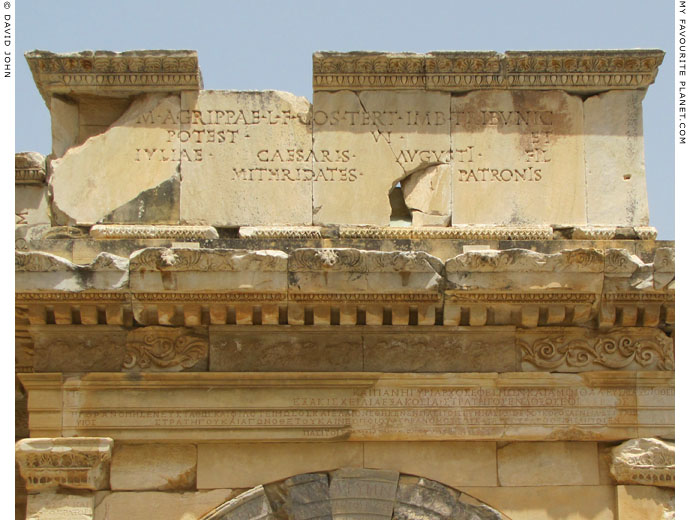
The eastern inscription, over the right arch of the gate, signed "Mithridates".
The inscription in Latin mentions Augustus' daughter Julia (Julia the Elder) and her husband
Marcus Vipsanius Agrippa. Agrippa was one of Augustus' most trusted generals and political allies.
He had been named as Augustus' successor, but died in 12 BC. After his death he continued to be
honoured in many cities of the Roman Empire.
M • AGRIPPAE • L • F • COS • TERT • IMB • TRIBVNIC
POTEST • VI • ET
IVLIAE • CAESARIS • AVGVSTI • FIL
MITHRIDATES • PATRONIS
Read more about Emperor Augustus and his relationship to Agrippa
on Athens Acropolis gallery, page 8: The Pedestal of Agrippa. |
| |

Below the inscription over the central arch is a relief showing the goddess Aphrodite,
with tiny winged Eros figures (Erotes) lifting her braids. Underneath is the beginning of
another inscription, with the Greek words "ΑΓΑΘΗΙ ΤΥΧΗΙ" (AGATHE TYCHE, Good Fortune)
which were often used to precede the main text of official inscriptions and decrees.
See also the photo on the next page. |
| |
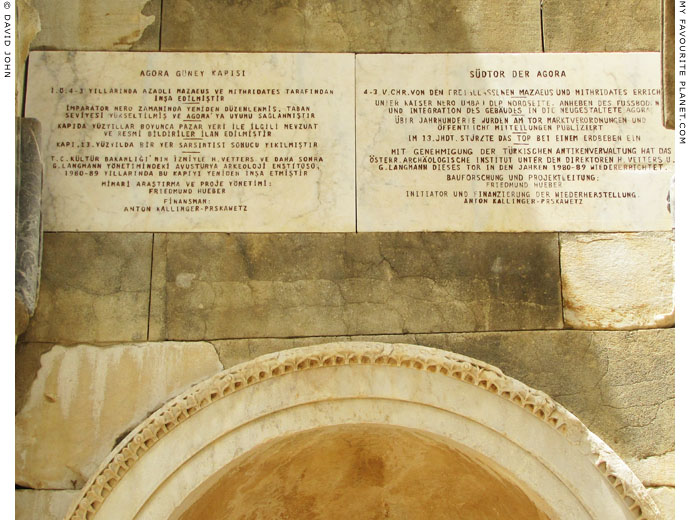
Modern inscriptions in Turkish and German inside the gateway commemorating
its reconstruction 1980-1989 by the Austrian Archaeological Institute (ÖAI),
under the directorship of H. Vetters and G. Langmann. Architectural research and
project director: Friedmund Hueber. Initiator and financing: Anton Kallinger-Prskawetz. |
 |
|
|
|